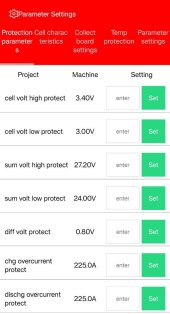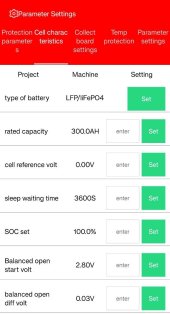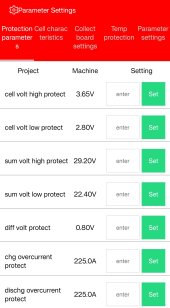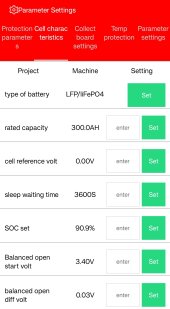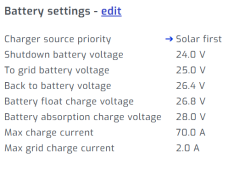Hi everyone, I think I'm writing in the right section of the forum.
I'm making this post to get some tips on the configuration of my new PV system, to which I recently added a LiFePo4 battery.
These are the components of my system.
Hybrid Inverter: Easun SMG II 3.6 kW
BMS: Daly SmartBMS 8S 24V 150A
Batteries: 8x Prismatic EVE LF280K
What I would like to do is to use my batteries in the 80-20% range so that I can extend their useful life as long as possible. However, I am confused between the different voltage parameters that I can configure in both the BMS and the inverter.
For the BMS, I have configured Daly's SmartBMS app as you see in screenshot 1 and 2.
For the inverter, the manual recommends changing the parameters that I have shown in the third screenshot.
Could you help me understand what values I need to put in? I think I have some confusion in my head and could use some help from you guys. I read the beginners guide to voltages, but I'm still confused about the inverter values.
I'm making this post to get some tips on the configuration of my new PV system, to which I recently added a LiFePo4 battery.
These are the components of my system.
Hybrid Inverter: Easun SMG II 3.6 kW
BMS: Daly SmartBMS 8S 24V 150A
Batteries: 8x Prismatic EVE LF280K
What I would like to do is to use my batteries in the 80-20% range so that I can extend their useful life as long as possible. However, I am confused between the different voltage parameters that I can configure in both the BMS and the inverter.
For the BMS, I have configured Daly's SmartBMS app as you see in screenshot 1 and 2.
For the inverter, the manual recommends changing the parameters that I have shown in the third screenshot.
Could you help me understand what values I need to put in? I think I have some confusion in my head and could use some help from you guys. I read the beginners guide to voltages, but I'm still confused about the inverter values.



